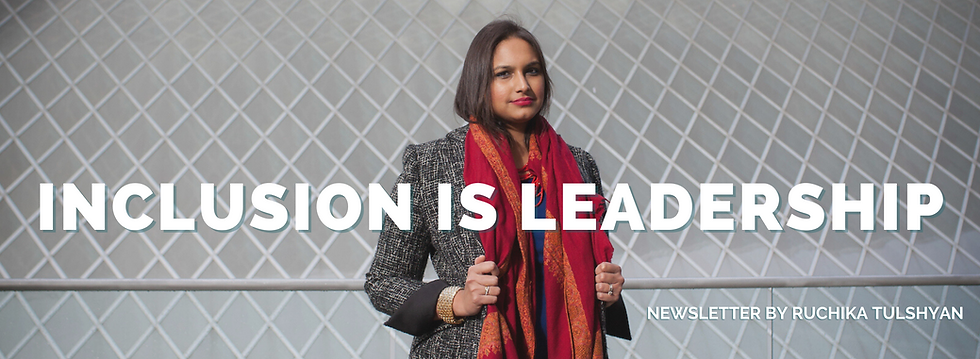When People Aren't Curious, it Breeds Exclusion
- Ruchika T. Malhotra
- Nov 3, 2021
- 3 min read

I see a disturbing lack of curiosity in professional and social settings.
It concerns me. Without being curious about other people and their experiences, we can’t build empathy or a diversity of relationships.
And what I’m realizing more and more strongly is that we each have a personal responsibility to take action to practice inclusion in every interaction.
I am not saying systemic change doesn’t need to happen — it does. But how do systems change? Through people. And how do people change? By introducing ourselves to new experiences and perspectives.
The lack of curiosity coincides with a shift happening in management and leadership all over the world: your work self and home self are inextricable.

A Life of Inclusion
Who you are at work and outside of work is the same person. “Work life” and “home life” don’t exist on separate planets; it’s all “life.”
The pandemic made this impossible to ignore, and it applies to caregiving, mental and physical health, relationships, and yes, inclusion. Especially inclusion.
You could be an effective manager to a team of people from all backgrounds. But when you go home, is your social network all white or male or heterosexual?
When you go out to eat, shop, buy a book or watch a movie, do you meaningfully and intentionally seek out options from lesser-heard communities? How about when you network, attend a PTA meeting, or take a class? Are there many people who don’t look like you?
If the answer is no, it’s time to cultivate curiosity intentionally. But how?
“Where are you from?”
This isn’t everyone’s reaction, but it surprises me when I meet someone and they don’t ask me where I’m from. 🤷🏽♀️ It’s harder still when I say “Singapore” and they ignore me in favor of bonding with the guy next to me over his hometown of Peoria, Illinois (no shade to Illinois, but why don’t we display equally respectful curiosity or excitement, no matter where the person is from?).
Personally, I’ve learned so much from asking “where are you from”!
Ok, I know! It’s a fraught question, often implying you don’t belong here. And to be clear, “where are you from” followed by “no, but where are you really from” is never an acceptable line of questioning (see why here).
But avoiding that question altogether can feel like a dismissal, akin to supposed (and problematic!) “colorblindness.”
There are numerous ways we avoid exploring our differences, perhaps out of awkwardness or fear of offending someone. But inclusion doesn’t happen by accident.
That means if left to our own “natural” devices, we might never extend a hand to someone different from us, especially in our personal lives. In my last Inclusion Is Leadership, Jennefer Witter commented, “In most of my experiences the majority of my staff were white and had never worked for a POC. One of the things I learned was that many had no interaction with people outside their race outside of the workplace.”
That has to change.
To practice inclusion in what you eat, read, watch, or buy is relatively easy — after all, you don’t have to put yourself out there. But what about interacting with people?
This is where we must be open and curious. And we can’t do that without asking questions.
So the next time you attend a conference, join a yoga class, or volunteer at your children’s school, be curious about someone different from you. Approach them with a smile and introduce yourself. Ask some questions. Most importantly, listen intently and make eye contact (even above a mask or virtually).
What questions do you ask when you meet someone new? If you’re a person of color or immigrant to the country where you live, what do you think of “where are you from”? What’s your go-to approach to connecting with a new person?

.png)
Commentaires